The dynamics of the world around us is changing and so are the expectations on HR systems
The case of change for our on-premise customers to go to the cloud lies essentially outside of the organization. There is a lot of technological development going on in the world around us and it is going at much faster pace than ever before. What is happening is that through the availability of the Internet, collaboration tools and knowledge sharing, people can work together to get to results way faster than ever before. If we look at the dissection of the human genome, the medical advancements allowing the analysis of the HIV virus, that kind of developments are really shaking the world up and it is changing the world around us at unprecedented pace of change and innovation. This unprecedented pace of change also leads to the fact that we do not exactly know what kind of skills and jobs will be needed in 5 years. The only thing we know is that if we want to be sustainable in organization coming forward to the future we will have to be prepared and flexible enough to respond to anything that future holds for us as an organization. And therefore, flexibility and speed to adjust are the essential criteria that make the case of change to move from the on-premise environment to the cloud environment because that is the only sustainable way forward in terms of innovation, and consuming innovation so we can help customer’s managers and employees within their organizations. Now, if we look at SAP, SAP is a technology vendor that has always been part of journey for our customers.
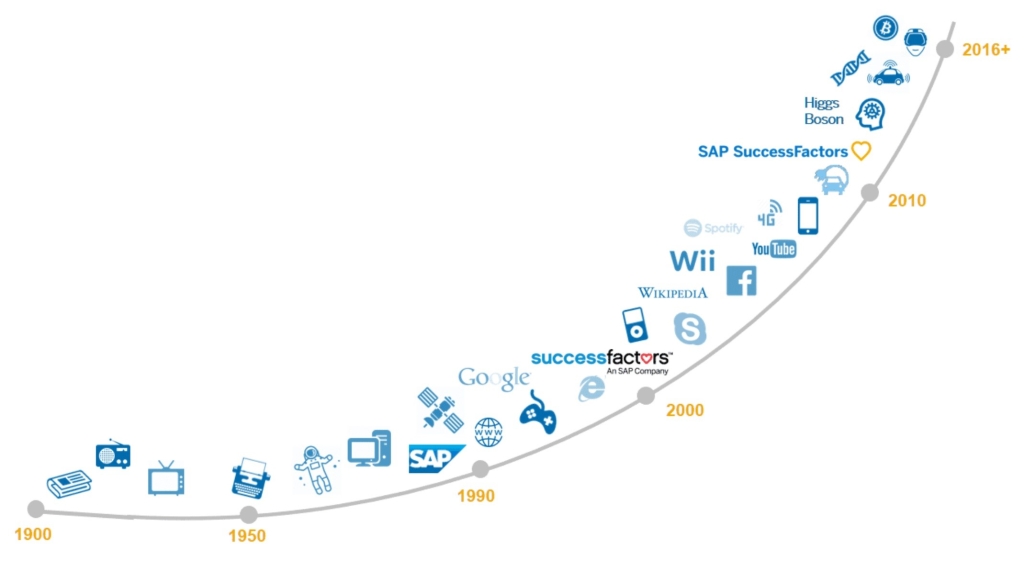
Increasing pace of change in technology
Although executives, analysts, and experts regularly try to predict where business is headed, the pace of innovation continues to exceed our expectations and imagination – especially when it comes to the world of work. Not only is technology impacting how we work and interact with each other, it’s transforming what we do for work.
According to the recent study of Duke University professor, Cathy N. Davidson, 65% of children entering grade school now and in the years to come will assume careers that don’t yet exist.
How can we possibly plan for a future workforce with jobs we can’t today know? And how can we develop talent when we don’t know what our business will need not just in a few years, but even in a few months from now?
We don’t know exactly what the future holds for us, but organizations need to be flexible and fast enough to respond to it to stay competitive and sustainable for the long run. Flexibility and speed to adjust are the essential criteria that make the case for change to move from an on-premise environment to a cloud environment. That is the only sustainable way forward for innovation and consuming innovation. SAP has always been a part of that journey for our customers.
Today’s systems must be an ongoing destination for employees that encourages continual usage. It is used to help them manage their work, plan their careers, develop new skills, and support changes in their personal lives – all on an ongoing basis. What good is an HR system investment if employees only use it sporadically twice a year – and when forced. Today’s systems must also provide a personalized experience. They must be able to recognize – and cater to – different needs and expectations across a multi-cultural and multi-generational workforce. They need to be flexible enough to deliver processes based on who the individual is, what they do, and how they prefer to interact.
Today’s systems must transform data across multiple sources – HR, ERP, external networks, machine data – into actionable insight to plan, measure, and predict. They also must recommend actions based on available data and the experience of others. It’s no longer OK to provide generic information and let the end user sift through hundreds of options, s/he wants an “Allegro or “Amazon” experience: “Here are some suggestions based on what you bought in the past, what you’ve looked at, and what others like you have bought/looked at.
Finally, today’s systems must easily incorporate customer-unique processes into their environments. With HR, one size never fits all: HR often must support processes because of historical agreements and/or because they help differentiation the organization as employer of choice. Today’s systems must include a platform and services that enable anyone with an idea to build new innovations and allow customers to easily consume and connect them with their HR systems. The “single data model” for HR is a myth: it always was, it is today, and it will be in the future. Especially today, organizations can’t rely solely on one vendor, it’s too slow: they will wait longer and longer and miss unique ideas that can help them thrive.
Today the buzz around Digital Transformation doesn’t equal “Automation”. More is needed to move beyond automation and begin digitally transforming. True company success relies on the people in the organization. They are at the heart of success, but their expectations are changing – all driven by the relentless and exponential pace of technology and digitalization. Put simply, employees today expect their business systems to behave like consumer systems: They want to connect and network, they want to work anytime, anywhere, from any device, they want to own their careers and development, they may be contractors or ‘gig’ workers; and they’re from multiple generations and they want information they need to be pushed based on who they are and what they want.
Today, leading companies are meeting employees where they are, and delivering an experience that engages them and taps into their unique value drivers. HR is also meeting employees where they are, using digital technologies to facilitate self-led performance and career development, deliver insight for managers to action workforce data, and build an environment that helps prevent bias.
This is the “next generation of HR Transformation – the “Digital HR transformation”, one that builds on the efficiency and automation foundation and helps HR deliver the experience that employees expect and support the desired outcomes of growth and new capabilities.
Evolution of SAP ERP Architecture
In order to understand why Cloud is the only sustainable way forward it is good to take one step back and understand where our on-prem customers are coming from and actually where SAP also is coming from. Because SAP has always been part of the customer journey. So in the early days of the SAP HCM on-premise application, we delivered an application that was applicable for end users, with the raise of Internet and Portal technologies, we provided our customers with new layers of technology that enabled them to do Portals, and then when Employee Self Service and Manager Self Services became more popular, we provided our customers with technologies to actually do that. What happened is that over the years, the number of layers of technologies provided within the ERP HCM application grew to help our customers meet the demands of their organizations. But, and that is something that not many people know, if we look at a modern SAP ERP HCM installation with a FIORI look&feel, we roughly need let’s say ten layers of technology to make that work and those ten layers might be owned by different departments maybe even by partner and they all have to be kept in synch for new releases and patches.
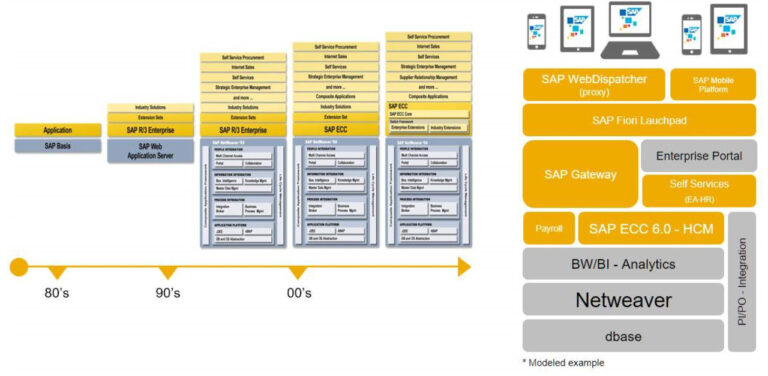
SAP SuccessFactors is about speed and futureproofing HR
As an illustration of the impact of these technological layers to enable that, we usually use a high-level calculation. So, if a customer wants to have a technical upgrade from one Enhancement pack to the other, they need to update all these technological layers. So, let’s say that is ten of these layers and every of these layers requires an installation, testing and integration testing so it takes two to three days per layer. That would mean that this will cost thirty days to do the technological upgrade, but every customer has a three-tier landscape so three times thirty is roughly ninety days and with these ninety days we have a technological update, while don’t even have implemented new functionality if that would be the case. So, if we link that back to the unprecedented pace of change that is going on in the world around us. It can immediately feel that there is a friction there and that is withholding our customers to be able to be flexible enough and agile enough to respond to these changes that are going on outside of their organization. And that is where the main added value lies of moving to the Cloud and moving to SuccessFactors as a cloud solution for SAP HCM.
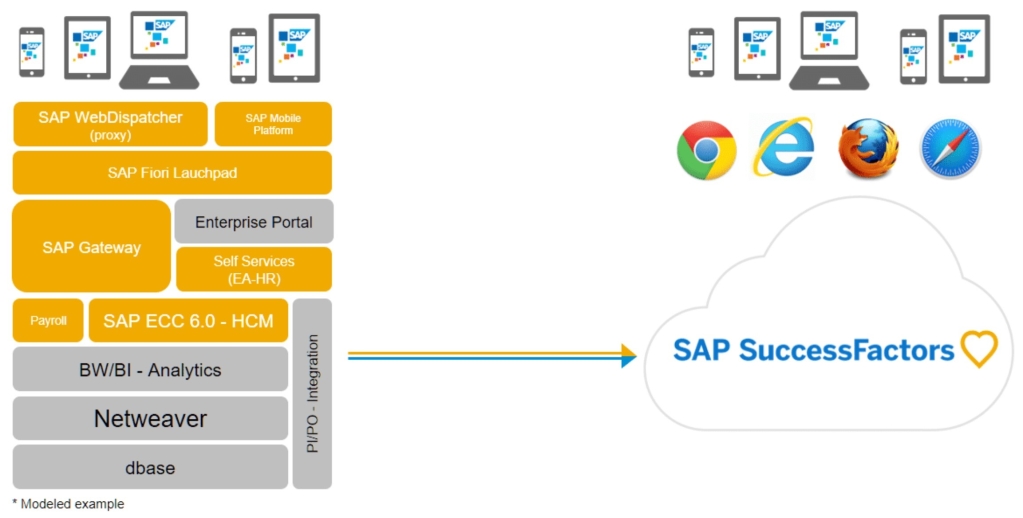
Cloud is changing our business process and the way that we work, across departments, companies and industries and SAP SuccessFactors and our Cloud is helping our customers.
Cloud provides faster access to innovation. SAP SuccessFactors manages our technology updates on a quarterly basis. Rather than having the demand for innovation, we provide new insights for how our customers should be running their businesses. Companies can measure their employee performance and goals in ways like never before to improve their business processes. We’ve also made data more available across the enterprise in what was previously siloed.
We help our customers reinvent the way they work. With our technology customers can empower their employees to work from anywhere – from their desktop to their mobile device – improving employee collaboration across geographies, functions and roles.
Faster access to innovation with quarterly release updates. SAP SuccessFactors manages the updates within our own data centers – our customers can easily click and provision these upgrades through the Upgrade Center (an administration console for upgrades). With our technology, data is more accessible across the enterprise – we enable our customers to gain new insights.
Employee Central as platform for Innovation. The new paradigm for companies is no longer just efficiency. In a world where everything is automated that can be automated, efficiency is no longer a key differentiator. In a fast-changing world, companies must learn how to become innovative and agile to survive and to stay competitive. The agenda of CHROs is clearly focusing on strategic business advisory and leading digital transformation. Every HR manager needs to get the whole picture. HR must act and show its full potential and help the business to create better results and to survive in this highly competitive environment.
All customers need to make sound people decisions to grow their business. But data is fragmented across the typical customer organization and outdated systems are difficult to use. SAP SuccessFactors’ Employee Central solves this problem. One single point of access for all users who need access to a certain kind of information – in real-time. This is what core HR should be – a central system of record with a consumer-like, intuitive user interface that captures key workforce data and uses it to contribute visibly to the business results. We are offering our customers a single view into all workforce data across geographies, cost centers, and employee types. This data can be later leveraged for any process automation and innovations to achieve broader reach of entire employee population and high granularity of fields to deploy processes and forms.
Due to the relatively high frequency of access to Core HR data and processes, simplifying and digitalizing processes, providing transactional self-services and mobile solutions are the key to success. Employee Self-Services and Manager Self-Services, continuous access to information about the organizational structure and people within the internal network, handing in leave requests, accessing mobile learning opportunities are crucial to increase the organizations’ efficiency and to manage human capital. This frequent access and usage of Core HR solution by employees increases adoption of other innovative processes and functionalities which are embedded into SuccessFactors solution. Employee Central is always described as the fuel for innovation by SuccessFactors customers.
We have finally arrived in times when we do not have to torture HR departments and employees with time-consuming, error-prone paper work, Excel spreadsheets and complex processes anymore. The time that employees can save is exactly the time, that they can be productive and create value. For HR getting rid of these administrative tasks means time to create a people plan and take over their true role as the most valuable business advisor for the CEO.
To put it into a nutshell, Employee Central is the foundation for latest innovations in core process automation and the most powerful drivers of digital transformation. Moving to the Employee Central system proves to have positive impact the whole organization and solving several problems at once.
Not only does it reduce costs significantly by simplifying all HR processes, but further is it key to open all new doors companies must go through to be still existing tomorrow.
Total Workforce Management a contingent labor trend. The modern workforce is multigenerational, culturally diverse, highly mobile, and includes increasing number of contingent workers. It’s almost too much to track and manage effectively as a whole. In a recent study IDC points out that only 10% of Western European HCM survey respondents were able to tap into talent wherever it is, through employment, contingent, contract, or freelancers. Yet up to 30% of large company HR spend goes towards contingent workers. With these employees now critical to the talent ecosystem, HR demands a redefinition of both the processes and how to best manage these people.
Getting their external workforce ready for tomorrow is one of the main issues that our customers are facing. Today’s employees even the externals want more coaching, career development, and performance incentives. If customers are unable to meet these needs, their top performers will find another employer who can or will chose the even more flexible option: working as a freelancer representing their own brand. With Fieldglass, our cloud solutions for external workforce management tightly connected with our SuccessFactors Cloud HCM solutions we enable our customers to tap on the external workforce and manage both core HR and talent processes.
Driver of Digital HR transformation – UX Experience/Cool factor. HR needs a front-end update to ensure a great customer/employee experience during the whole employee life-cycle. Therefore, all HR interactions must work smoothly and easily, on any device the employee is used to have at their disposal during a day of work. By moving their HCM system to the cloud, our customers can make their processes scalable, personalized and empower the human interaction at the same time through state of the art user experience.
From an employee perspective, the digital HR experience starts with a beautiful and intuitive platform offering one entry point for all HR related applications. Cloud based intuitive User Interface systems are perceived as forward looking, tech enabling factors. They have a high “cool” factor among Millennials and generation Z. The Cool factor drives employee engagement, reduces turnover, and makes an employer a desired place to work.
What also drives great UX experience is that we enable our customers to use Employee master data together with Artificial Intelligence and Machine learning to position personalized content to their employees. Offering continuous learning opportunities wherever, whenever and whatever content fits the individual is opening new career paths and is making knowledge manageable for our customers. Imagine we know that a company’s product or service will not be demanded anymore in 5 years. The business leaders might just use the resources available to produce another product, but how do we ensure that the workforce is also ready to execute new tasks? It is the responsibility of HR to ensure that the human resource is ready for change and to adapt to changing business needs.
Recently the Wellness and Wellbeing programs arose out of the changing expectations and needs of employees of today’s work environment. SuccessFactors has integrated the performance boosting initiatives into its system, thus into daily work life of every individual within the company. Thanks to this, every employee can access the resources they need and want whenever they feel overwhelmed and want to calm down and focus.
Finally, keeping in mind the whole employee life-cycle to attract, to retain and to develop all kind of talent available starts with a mind-blowing image and application experience, personalized Onboarding. Available now in SuccessFactors, increasing employee engagement to a maximum by offering employees opportunities they can imagine and ensure they have all the means to grow side-by-side with our customers business.
From the employer perspective the most crucial, but still the most complex change and difficult to master in mindset, must be to accept, that current and potential employees must be treated like customers. The power of a digital HR experience therefore is higher than one would think at the first glance. To get the best people and to keep them within company, customers must offer them the freedom to become everything they want. Continuous feedback and individual, always-available mobile learning are the basis this culture must be built on. Continuous, “check-in" style personal development — engaging HR processes for performance, learning/development, and more regular feedback from peers and supervisors is the norm by now.
Workforce Transparency and Embedded HR Reporting. Our Core HR solution Employee Central offers the opportunity to clean up employee master data and set up centralized and standardized HR reporting and dashboards embedded in SuccessFactors. Analytical capabilities and reports can be extended into other modules if needed and just-on-demand for reports (e.g. Learning, Compensation, Recruiting). This feature is not only of interest to Senior HR Executives, HR Business Partners, Managers, but also to the office of the CFO and Controlling. Customers expanding to new markets regularly face the challenge to rollout HR to newly founded or acquired subsidiaries. While this is cumbersome with SAP HCM on-premise, it goes fast and easy with EC: Standard, pre-configured reporting content combined with quick deployment options.
Extending SAP SuccessFactors with SAP Cloud Platform. Enterprise’s need to be agile to respond to new business requirements as they arise and ensure that HR has a strong presence of the executive table. If our customers are running in hybrid environment, they cannot be held back by highly customized on-prem solutions which hinder their ability to adopt new trends. Customers need to provide a unified user experience across the back-end and front-end systems. For our customers it is also important to be able to adapt to unique industry or regional requirements that are not part of their core solution.
So, what it means to extend and complement the SAP SuccessFactors suite? Consider a case when a customer has already implemented SuccessFactors and they are tracking occupational health and safety incidents in a spreadsheet or managing labor relations outside of the system. In this case extensions for regulated industry or unionized environment can help customers to stay compliant in a seamlessly integrated purpose-built app. Another common scenario is when customers are running SuccessFactors along with several other SAP or third-party applications and they want to ensure that integration is seamless and optimized or perhaps they simply want to implement a real-time team feedback survey tool that can be integrated simply and quickly into SAP SuccessFactors. There is an easy way to do all of this. It is called SAP Cloud Platform. It is the Enterprise Platform as a Service to extend SAP SuccessFactors with seamless data and process integration. There are a multitude of partner apps that can help customers address many HR needs with everything from Health & Wellness to compensation analytics and detailed Job Description management. These extensions natively integrate into SAP SuccessFactors. This ensures a seamless user experience putting customers people at the center of their business.
HR is a highly innovative space and its future holds endless possibilities. SAP Cloud Platform empowers customers to use cutting-edge technologies like chatbots, machine learning or powerful analytics to facilitate strategic decision-making. Customers can unlock data from multiple sources and leverage it in many ways to write the future of HR.
Reasons for customers to move to the cloud
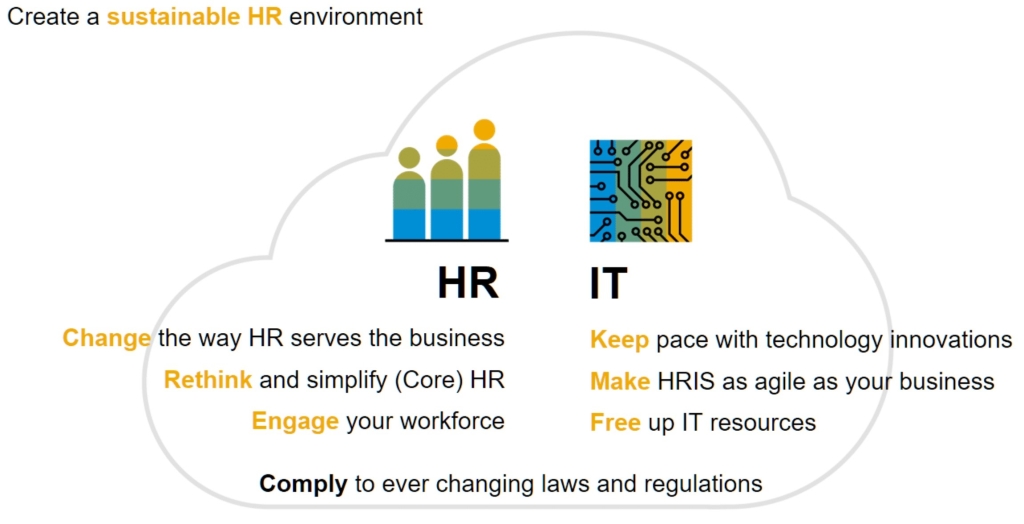
So, if we take all the above reasons into account and into consideration we can also immediately understand why some of the HR departments sometimes complain about their IT departments that they don’t deliver timely solutions to what they actually need. We can also feel the dilemma of the IT people that want to deliver technology solutions, but it is very hard because they must keep all these technological layers in synch to deliver something that is useful for their organization. So, for both parts of the organization, the reason to move to the cloud is a little bit different. For HR it is about the changing the way HR serves the business, optimizing processes, rethinking those processes, but also engaging the workforce with modern day applications that come with features and functions when customers need them as they need them. And on the IT side it is about keeping up with the pace of technological innovations and bringing that to the business and run HRIS’s as agile as the business is.
And by doing so enabling their organizations to transform digitally. And we know that digital pays. According to Oxford Economics “Leaders 2020” report, 38% of the organizations that have gone into digital transformation are more likely to report strong financial performances. And we also see that there is a higher employee satisfaction by using these solutions, so why wouldn’t we do that. There is a huge business imperative to do the change.
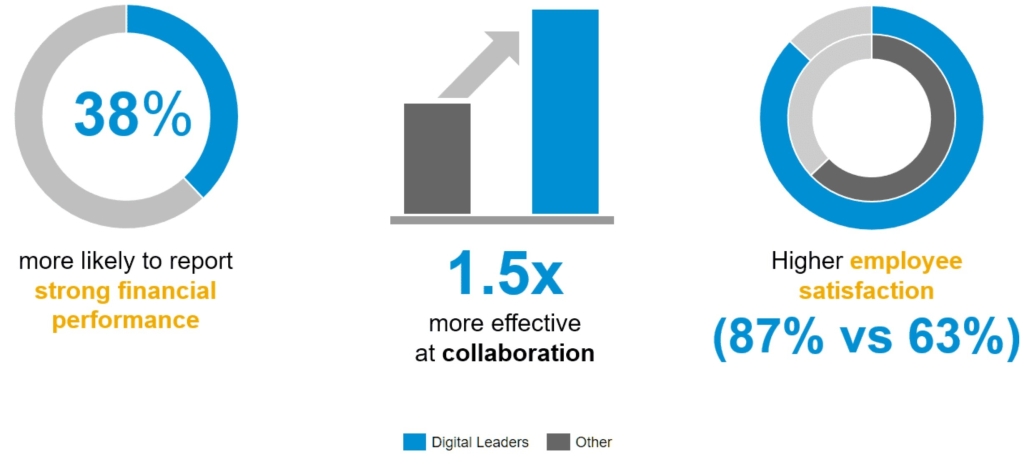
We are supporting our customers Journey
SAP has been the technology partner of choice in HCM for more than 30 years. We have retained “trusted advisor" status because we provide the latest self-service, portal, and mobile technologies. We have remained agile in response and know our customers’ needs.
We are at another crossroads in the evolution and see the market quickly changing; the time required to adopt the innovations at the customer side is increasingly outpaced by market expectations of technologies and the subsequent demand from employees and managers within a customer organization.
By deploying the latest HCM technology via cloud, our customers and their employees will keep pace with the market.
Next to the business opportunity of our customers, there is a huge market opportunity for SAP SuccessFactors. At the moment we roughly have 13,000 SAP ERP HCM on-premise customers out there. And out of those 13,000 customers roughly 10% have bought SAP SuccessFactors solution. So, there is an enormous potential for us to create more business by approaching our on-premise installed base.
To reach to and educate those on-premise customers we have created the Upgrade2Success program which provides clear guidance, predictable outcomes, and faster time to value to help these customers ease the migration to cloud-based SAP SuccessFactors solutions.
Upgrade2Success program highlights
Upgrade2Success is a strategic program within SAP SuccessFactors to provide our on-premise installed base customers with tools, assets and services to make migration easier. The Upgrade2Success approach is a little bit different than normal in a sense that we also include one to many events. We do these one to many events to stimulate interaction, conversation and knowledge sharing between our customers and our experts. And that way we learn and understand where our customers are on their journey, but it also gives us an opportunity to bring in our vision and our approach before the competition even does. And in turn that helps us to build relationship of trust with our customers that opens them up to invest in any orderly transition going forward, investing in our cloud solutions because they feel they can trust SAP as a technology vendor and our solution as the way forward.
Our customers tell us that successfully migrating to and adopting SAP SuccessFactors must focus on some key topics.
We know where our customers come from, and we have been part of this technology journey for years. That does not mean that we want to assume anything regarding their needs and requirements. We have been listening to our customers and incorporated the customers voice into Upgrade2Success tools, assets and services. Surely, our on-premise customers want a modern UI, reduce the HR cost per employee, and enable automation to allow for focus on strategic work and that is what SuccessFactors product is all about. Next to that our on-premise customers want to know how we help with simplifying their processes, help with data migration and integration.
What does the Upgrade2Success program provide?
- Knowledge and expertise from SAP
We know our customers and what their SAP HCM on-premise solutions provide today. And with that knowledge and expertise, we can effectively advise them on the best way to transition to the cloud while optimizing their HR capabilities and investments in SAP technology.
- A jumpstart to the transformation journey
Moving to the cloud enables customers to rethink their HR processes and we can make sure they don’t have to start from scratch. SAP delivers a process library of leading practices with cloud subscription and offers SAP HR Model Company deployment services to jumpstart customer journey.
- Data migration and integration like no other
We created tools that can help ensure the safe and complete migration of customer HCM on-premise data model and structure to SAP SuccessFactors solutions. We also deliver tools for easy, efficient and reliable integration to the rest of customer enterprise systems, whether from SAP or others.
- The power of a strategic partnership
We will be on this journey together. The recognized expertise of the SAP ecosystem and partners can support customers with a consistent methodology and set of tools that will guide them through every step.
To find out more about the Upgrade2Success initiative please visit our Resource Centre or email me.
Demystifying move to the Cloud
Our on-premise customers sometimes also have objections to what we have to say. Something that comes up a lot is that the IT people fear that they lose their jobs. They have an IT and development team, they are working on SAP on-premise, and they are afraid that when they move to the cloud there will be less jobs. Here is when we explain it right to the customer that their teams would still be able to develop and add value. In other words, their jobs would not be replaced or be lost but they would probably be changing, and the focus would be on consumption of innovations and governance around that and how to integrate but also on how to help business run a project in a structured way. For their developers looking at SAP Cloud Platform would be a very good perspective to the future. And share with them that we’ve opened the development platform to all Apple, Google and Microsoft developers, so they would be in a good company if they would be looking for work in the future in IT.
Another interesting objection coming from on-premise customers is: “We are unique, and we do not fit the Cloud solution. We are heavily customized on SAP HCM on-premise, so we don’t know if we would fit.” And an interesting thing that comes up when we do a high-level assessment is that 80% of the functionality required will normally be for instance in Employee Central. And if we zoom in to the additional current functionality it would probably be plotted somewhere else in the standard functionality of the SAP SuccessFactors solution. Sometimes we have minor differences because SAP on-premise application was designed in totally different era as the cloud application. And sometimes this customer required functionality is on the Roadmap of SuccessFactors solution. Then with the few remaining requirements that we have left, we might be able to create a proof-of-concept or investigate Metadata Framework or SAP Cloud Platform as a development platform. Bottomline is that we can actually dispel the myth and if we look that large and global enterprises or complex enterprises have to have a custom HCM on-premise application, that is simply not true anymore.
A third objection that comes in many conversations with customers is: “We have too many integrations built into my HCM on-premise. I cannot move to the Cloud. I am heavily customized.” There are several ways of looking at it. In some cases, these integrations go away because customers are going to use the SAP SuccessFactors suite of products and then integration is going to be handled within the product. But in case that it is very important, then a Side-by-Side model could be proposed and in that model the users will all use the SuccessFactors product, which will also hold the Masterdata and therefore the Masterdata feeds into the SAP on-premise solution as a slave of for instance Employee Central. This would allow that all the integration points that they have today would stay in place and in full use while getting the team started on an HCM transformation journey with Employee Central.while getting the team started on an HCM transformation journey with EC.while getting the team started on an HCM transformation journey with EC.
A fourth objection we sometimes see is that our customers do not trust SAP because in a prior experience they were over time and budget implementing HCM on-premise. Now of course the implementation approach for the cloud solution is totally different with design and build iterations it is weeks instead of months before we see something that is relevant and sometimes customers must understand that. Another option to build trust is to invite the customer to one to many Upgrade2Success roadshow events where they can speak with other customers that have been on the journey, they can speak with reference customers, they can speak with experts from our organization. They can discuss any concern they have going forward.
Another objection that we hear is that our customer needs to show rapid results. They cannot afford a yearlong project. In that case the HR Model company (our Leading practice processes and configuration) is the way to go. The HR model company is part of the approach for Upgrade2Success and we have leveraged the tools like the EC Infoporter to have templates that fit perfectly from SAP HCM on-premise to HR Model Company. On top of that we’ve also created factory services using these tools, so we can really jumpstart the implementation and migration of our customers and it will certainly reduce the timeframes that we are looking at.
As a final example of the objection that we sometimes hear back from our customers is that they think they will pay double licenses. Of course we know that theoretically it is not true because from SAP point of view, every user has to be licensed only once, but our customers also sometimes refer to what our competition is doing and specifically that they offer one-to-one maintenance over subscription offering when their customers are moving from on-premise to cloud and then the question is if SAP could offer them something similar and of course we do offer it. We offer the Cloud Extension Program for our customers. Customers need to look at the current configuration of their on-premise licensing and what we can derive from that to use for the Cloud Extension Program.

